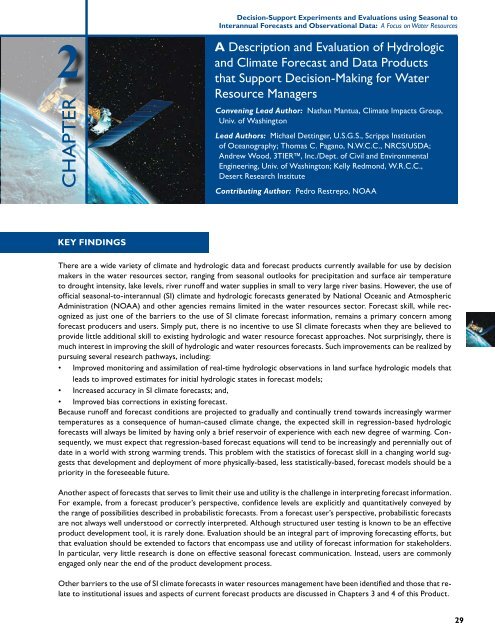Decision support experiments and evaluations using seasonal to ...
Decision support experiments and evaluations using seasonal to ...
Decision support experiments and evaluations using seasonal to ...
You also want an ePaper? Increase the reach of your titles
YUMPU automatically turns print PDFs into web optimized ePapers that Google loves.
CHAPTER 2<br />
KEY FINDINGS<br />
<strong>Decision</strong>-Support Experiments <strong>and</strong> Evaluations <strong>using</strong> Seasonal <strong>to</strong><br />
Interannual Forecasts <strong>and</strong> Observational Data: A Focus on Water Resources<br />
A Description <strong>and</strong> Evaluation of Hydrologic<br />
<strong>and</strong> Climate Forecast <strong>and</strong> Data Products<br />
that Support <strong>Decision</strong>-Making for Water<br />
Resource Managers<br />
Convening Lead Author: Nathan Mantua, Climate Impacts Group,<br />
Univ. of Washing<strong>to</strong>n<br />
Lead Authors: Michael Dettinger, U.S.G.S., Scripps Institution<br />
of Oceanography; Thomas C. Pagano, N.W.C.C., NRCS/USDA;<br />
Andrew Wood, 3TIER, Inc./Dept. of Civil <strong>and</strong> Environmental<br />
Engineering, Univ. of Washing<strong>to</strong>n; Kelly Redmond, W.R.C.C.,<br />
Desert Research Institute<br />
Contributing Author: Pedro Restrepo, NOAA<br />
There are a wide variety of climate <strong>and</strong> hydrologic data <strong>and</strong> forecast products currently available for use by decision<br />
makers in the water resources sec<strong>to</strong>r, ranging from <strong>seasonal</strong> outlooks for precipitation <strong>and</strong> surface air temperature<br />
<strong>to</strong> drought intensity, lake levels, river runoff <strong>and</strong> water supplies in small <strong>to</strong> very large river basins. However, the use of<br />
official <strong>seasonal</strong>-<strong>to</strong>-interannual (SI) climate <strong>and</strong> hydrologic forecasts generated by National Oceanic <strong>and</strong> Atmospheric<br />
Administration (NOAA) <strong>and</strong> other agencies remains limited in the water resources sec<strong>to</strong>r. Forecast skill, while recognized<br />
as just one of the barriers <strong>to</strong> the use of SI climate forecast information, remains a primary concern among<br />
forecast producers <strong>and</strong> users. Simply put, there is no incentive <strong>to</strong> use SI climate forecasts when they are believed <strong>to</strong><br />
provide little additional skill <strong>to</strong> existing hydrologic <strong>and</strong> water resource forecast approaches. Not surprisingly, there is<br />
much interest in improving the skill of hydrologic <strong>and</strong> water resources forecasts. Such improvements can be realized by<br />
pursuing several research pathways, including:<br />
• Improved moni<strong>to</strong>ring <strong>and</strong> assimilation of real-time hydrologic observations in l<strong>and</strong> surface hydrologic models that<br />
leads <strong>to</strong> improved estimates for initial hydrologic states in forecast models;<br />
• Increased accuracy in SI climate forecasts; <strong>and</strong>,<br />
• Improved bias corrections in existing forecast.<br />
Because runoff <strong>and</strong> forecast conditions are projected <strong>to</strong> gradually <strong>and</strong> continually trend <strong>to</strong>wards increasingly warmer<br />
temperatures as a consequence of human-caused climate change, the expected skill in regression-based hydrologic<br />
forecasts will always be limited by having only a brief reservoir of experience with each new degree of warming. Consequently,<br />
we must expect that regression-based forecast equations will tend <strong>to</strong> be increasingly <strong>and</strong> perennially out of<br />
date in a world with strong warming trends. This problem with the statistics of forecast skill in a changing world suggests<br />
that development <strong>and</strong> deployment of more physically-based, less statistically-based, forecast models should be a<br />
priority in the foreseeable future.<br />
Another aspect of forecasts that serves <strong>to</strong> limit their use <strong>and</strong> utility is the challenge in interpreting forecast information.<br />
For example, from a forecast producer’s perspective, confidence levels are explicitly <strong>and</strong> quantitatively conveyed by<br />
the range of possibilities described in probabilistic forecasts. From a forecast user’s perspective, probabilistic forecasts<br />
are not always well unders<strong>to</strong>od or correctly interpreted. Although structured user testing is known <strong>to</strong> be an effective<br />
product development <strong>to</strong>ol, it is rarely done. Evaluation should be an integral part of improving forecasting efforts, but<br />
that evaluation should be extended <strong>to</strong> fac<strong>to</strong>rs that encompass use <strong>and</strong> utility of forecast information for stakeholders.<br />
In particular, very little research is done on effective <strong>seasonal</strong> forecast communication. Instead, users are commonly<br />
engaged only near the end of the product development process.<br />
Other barriers <strong>to</strong> the use of SI climate forecasts in water resources management have been identified <strong>and</strong> those that relate<br />
<strong>to</strong> institutional issues <strong>and</strong> aspects of current forecast products are discussed in Chapters 3 <strong>and</strong> 4 of this Product.<br />
29




